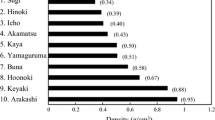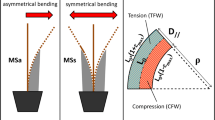Abstract
In this paper we focused on the differences of mechanical properties of tension and normal wood of 1-year-old poplar trees, artificially tilted. Elastic and fracture properties have been measured and linked to the anatomy. Tension wood is well known because it prevents good surface finishing and leads to difficulties with sawing. We studied three main mechanical properties: young modulus, energy of cutting and longitudinal residual strain of maturation (with strain gauges) because of their importance in wood technology. Moreover, this work takes place in a larger project of study, the phenomena of axes re-orientation in trees (allowing by the production of reaction wood), where these data are required for biomechanical modelling. The results show that tension wood has a higher young modulus, needs a higher energy to be cut and exhibited a higher level of longitudinal residual strain of maturation than those of normal wood. The results suggest that these differences require deeper analysis of the wood than anatomy: measurement of microfibril orientation in the S2 layer and also the lignin composition in monomeric units.








Similar content being viewed by others
References
Atkins AG, Vincent JFV (1984) An instrumented microtome for improved histological sections and measurement of fracture toughness. J Material Sci Lett 3:310–312
Baillères H, Chanson B, Fournier M (1994a) Two field measurement techniques for appraising the longitudinal growth strains at the stem surface. In: Plant biomechanics, Conference Proceedings, Montpellier, pp 23–24
Baillères H, Chanson B, Fournier M, Tollier MT, Monties B (1994b) Structure, composition chimique et retraits de maturation du bois chez des clones d’Eucalyptus. In: Thibaut B (ed) Architecture, Structure et Mécanique de l’Arbre. 7ième séminaire interne, Montpellier, 5–7 Avril
Bamber RK (1978) Origin of growth stresses. Forpride Digest 8(1):75–90
Boyd JD (1972) Tree growth stresses V. Evidence of an origin in differentiation and lignification. Wood Sci Technol 6:251–262
Edelin C (1984) L’architecture momnopodiale: l’exemple de quelques arbres d’Asie tropicale. PhD Thesis, Université Montpellier II
Fisher JB (1985) Induction of reaction wood in Terminalia (Combretaceae): role of gravity and stress. Ann Bot 55:237–248
Fisher JB, Mueller RJ (1983) Reaction wood and reorientation in leaning stems of balsa (Ochroma) and papaya (Carica). Can J Bot 61(3):880–887
Fournier M, Bailleres H, Chanson B (1994) Tree biomechanics: growth, cumulative prestresses and re-orientations. Biomimetics 2(3):229–251
Huang X, Jeronimidis G, Vincent JFV (1999) Fracture properties of wood from transgenic poplar plants with modified lignification. Symposium of Chinese Youth Scholars on Materials Science and Technology, Beijing, pp 1–10
Hughes JF (1965) Tension wood: a review of the literature. For Abstr 26:1–16
Illston JM, Dinwoodie JM, Smith AA (1979) Concrete, timber and metals. Van Nostrand Reinhold, New York, pp 128–130
Jankiewics LS, Stecki JZ (1976) Some mechanisms responsible for difference in tree forms in: Cannell MGR, Last FT (eds) Tree physiology and yield improvement. Academic Press, London, pp 157–172
Kelly A (1970) Interface effects and the work of fracture of fibrous composites. Proc R Soc Lond A 319:95–116
Oldeman RAA (1974) L’architecture de la forêt guyanaise, Mémoire Orstom, no 73, Paris
Sassus F (1994) Déformations de maturation et morphologie chez le clone de peuplier I214. In: Thibaut B (ed) Architecture, Structure et Mécanique de l’Arbre. 7ième séminaire interne, Montpellier 5–7 Avril
Sinoquet H, Moulia B, Bonhomme R (1991) Estimating the three-dimensional geometry of a maize crop as an input of radiation models: comparison between three-dimensional digitising and plant profiles. Agric For Meteorol 55:233–249
Thibaut B (1997) Tree biomechanics and related problems in wood technology. In: Jeronimidis G, Vincent JFV (eds) Plant biomechanics, Conference Proceedings I, pp 157–170
USDA (1974) Wood handbook, forest products service, handbook no 72.USDA
Wardrop AB (1964) The reaction anatomy of arborescent angiosperms. In: Zimmermann MH (ed) Formation of wood in forest trees. Academic Press, New York, pp 405–456
Wilson BF (1990) The development of the tree form. Hort Sci 25(1):52–54
Wilson BF, Archer RR (1979) Tree design: some biological solutions to mechanical problems. Bioscience 29:293–297
Acknowledgements
We greatly thank Mr Stéphane Ploquin and Mr Patrick Chaleil (INRA-piaf, Clermont-Ferrand, France) for their help during field experiments and useful practical advises, Mr John Frew and Mr Tim Holt (Department of Engineering, University of Reading, UK) for their help in preparing and testing the wood specimens and Mr Xiahua Huang (Centre for Biomimetics, University of Reading, UK) for his advice on the use of the instrumented microtome and Mr Gril (Laboratoire de microscopie électronique, Université de Montpellier II, France).
Author information
Authors and Affiliations
Corresponding author
Rights and permissions
About this article
Cite this article
Coutand, C., Jeronimidis, G., Chanson, B. et al. Comparison of mechanical properties of tension and opposite wood in Populus . Wood Sci Technol 38, 11–24 (2004). https://doi.org/10.1007/s00226-003-0194-4
Received:
Published:
Issue Date:
DOI: https://doi.org/10.1007/s00226-003-0194-4




